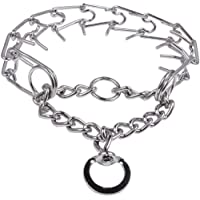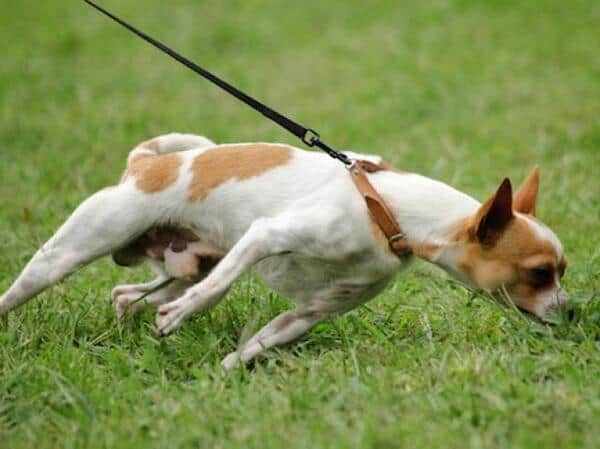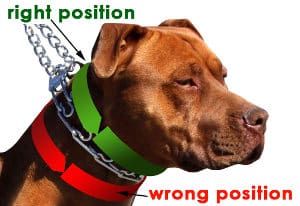Some people use some kind of prong collar to control dogs during a walk. Those who support this often will only say that it seems to work, while some supporting trainers also try to imagine more reasons to justify it. As those opposing will often go into even more detail, we’ll start at that end, looking to see what is actually true, and to what degree.
The first review case here is a good example of an author who badly stumbled while attempting to go far past her own knowledge. However, the second review is a far more comprehensible and accurate discussion of an issue with prong collars. Curiously, it was penned a few years ago by the very same author.
Both are presented to examine some of the false arguments that can be found, even when the conclusion is mostly correct. As these analyzes can get a bit long, I’ll start off with my own conclusions first, instead of posting them at the end.
Prong Collars

Prong collars are a type of restraint which causes more discomfort when pulling than a strap collar, and may also cause pain and potential damage. While all restraints are capable of causing damage, prong collars are more likely than most others, as all the force is focused on the narrow prongs, instead of a longer strap collar or harness. They come in 3 sizes: small 2.25mm, medium 3.0mm, and large 4.0mm (0.08, 0.118, 0.158″).
Comparing them to something like a common strap collar, it’s immediately obvious that the force from any leash pull will be focused on a much smaller area, resulting in a higher pressure against the neck in those areas. While we could now drop into physics and analyze the difference, the interpretation would be hazy as we don’t really know the thresholds for pain, or for skin and neck damage.
Why Do Some People Use Them?

By far, the single greatest reason is to prevent or reduce your dog’s pulling when walking on a leash. For the majority of people I’ve seen or spoken with, this is the primary reason and their goal, as opposed to also controlling the dog’s response when training.
I have also seen some trainers who use prong collars on most of their board-and-train clients, and sometimes in classes. In my opinion, the only reason they do this is that it is simpler to teach people how to use forceful restraint, then how to instead teach the dog the desired behavior.
Finally, I’ve read that a small number of trainers use tight prong collars simply to compel a more immediate response from the dog. A typical one might be Jeff Frawley, who claims:
We discuss some of the myths behind purely positive dog training and why we it simply does not work in the real world. While we teach with rewards, we are not nieve enough to believe that a dog will always mind when faced with extreme distractions (like another dog)
Jeff Frawley
Of course, there really is no such thing as purely positive dog training, and Jeff then implies that coercion instead of rewards is the only workable solution. So, I’ll just leave him sitting in the corner with the other extremes.
How Bad Are Prong Collars?
Just as with virtually any type of restraint, the degree of pain and discomfort depends on its usage. From what I’ve seen, in the vast majority of cases the prong collar is set pretty loose, and most dogs do not appear to mind it. At least not until they start pulling hard enough.
What happens then cannot be seen by putting the prong collar around your arm, or even your neck. Not unless you’ve got a really strong neck, which is also well covered by fur. I’ve seen many Pit Bulls with short fur still tugging hard enough that you could easily see the prongs indenting. But it seemed to be only mild discomfort and no resultant marks or damage. For fur like a Golden, that would be even more true as the longer fur distributes the pressure even more.
And if the dog is simply pulling as hard as he can and doesn’t stop? Damage is more likely with a prong collar, but could happen with any type of collar. However, due to the additional discomfort, the dog is less likely to do this with a prong collar.
If you had a dog starting to run when you snapped the leash hard enough to yank him off his feet, most any simple neck collar may cause damage. Sure, a prong collar may be worse, but even a strap collar can be pretty bad.
So the likelihood of damage comes down to how both the dog and the person behave. And I actually haven’t seen any evidence of damage in the majority of cases. Yes, you can find some gruesome pictures out there, but those are typically from embedded collars, which can also happen with just a simple strap collar.
What are Prong Collars Actually Teaching?
For this, try watching some people walking dogs who are repeatedly pulling. You’ll see the ones with prong collars just pulling a bit less, and some of those seem to hardly pull at all. I’ve seen some dogs who gave up on pulling after awhile, but only if the prong collar was on. And others who continued to pull, just not quite as hard as before.
For people who feel they are locked into a prong collar, I suggest starting with both a prong and strap collar, with two leashes. Over the course of a few weeks, slowly and gradually change to using the strap collar, returning to the prong collar only briefly as needed. For many dogs, this will then allow removing the prong collars.
Instead of starting with a prong collar, you could use some gentler and more versatile tools. And look into some methods which focus more on teaching behavior than using coercion. While these approaches will always have better results, for some the trade off is just too great. That is because those methods require you (the person) to stop pulling the dog, and to change your response when the dog starts to pull.

And, with some people, that simply isn’t going to happen. Sometimes the best you can do is to just help them in using the prong collar. Sure, I could take the dog away for a bit and leash train him. But, before long some of them will return to their previous responses to their owner’s behavior, and nothing will change until the owner changes.
The Reasons for These Reviews
Far too often you can find people on both sides of an argument who all lack the fundamental knowledge needed, but who will not allow that to impede their progress. Very often these may be prolific and entertaining writers, who can produce many pages so much faster than a more knowledgeable person who has to first examine the real issue, then find a readable way of presenting it to readers.
Twenty years ago this issue was less likely, as people then often had to actually open a textbook to find the details. Today, however, there are many hundreds of web pages on physics, levers, and all such. Few of which give you either a complete lesson on a topic, nor do they test your knowledge to see if you actually understood it.
Sadly, that seems to be today’s prevailing issue: That these authors actually believe they understand the material, and even get positive feedback from readers having the same deficiency. My detailed comments in the articles reviewed below serve to show just how badly wrong they can be.
For reference, here is the 15th edition of a popular physics textbook. One which I used many years ago, back in their 4th edition. While much of this can be found in various places on the web, you often have no idea if your selection happens to be badly incomplete or simply wrong. Nor would you know all the needed pieces or the best order in which to learn them.
University Physics, 15th edition.
Or, today one can instead just trot over to OpenStax.com for a free copy of their own version of University Physics.
The First Article, with An Excess of Physics
Because of the detail she included, we’ll start with a blog post on Questions to Ask About That Bizarre Prong Collar Diagram.
It’s very simple. Prong collars hurt dogs. They can hurt a lot, depending on how tightly they are fastened and the handler’s behavior. Sometimes the sensation may be as low as mild discomfort. But make no mistake: if wearing a prong collar gets your dog to stop pulling on the leash, it’s because it becomes uncomfortable to do so.
EileenAndDogs.com
First, in the spirit of full disclosure, I do not like prong collars. I do not use or recommend them. If working with a dog on a prong collar I remove it. If told the dog will not walk well without the prong collar, I prove that wrong. If none of the above is possible, I try to show the person the gentlest way to use it.
Given that, I’ve seen many dogs who show no discomfort with a prong collar. And yet other dogs suffering from just a strap collar. Yes, with a prong (vs. strap) collar, the potential for pain and harm is much higher. But to claim that always happens dilutes any argument. For there are many people using prong collars who will attest to their dogs not showing any discomfort, and will simply not believe anything further you say on the topic.
Unfortunately, some trainers who use prong collars will go to great lengths to defend them, often by making stuff up.
Which is true, but often applies just as much to nearly anything else the trainer supports, be it good or bad. And often nearly as much to the other extreme, as we’ll soon see here.
The Lack of Focus
I am going to critique a certain diagram (and a few other arguments about prong collars) I have seen online. But I won’t link to the diagram. I hate vague-posting, but I can’t see another ethical way through this swamp. I feel bound to say something about the misinformation, but I know that linking to it, even for criticism, will promulgate it. So I am in this weird position.
I really don’t see the ethical dilemma here. Simply linking to the diagram will not promulgate it any more than people reading this article who then go and search for the diagram. However, it does make it far more difficult to comment on her arguments against something which is not seen. Instead, I would have actually embedded the diagram. And if it really seemed that impressive, I would have preceded it with a more accurate diagram, made just as pretty.
Note that the people who post diagrams like this put on the mantle of science and accuse anyone who disagrees with them of being emotional. Ya know, if being emotional makes you realize that what your trainer recommended is hurting your dog, then more power to emotions. But here, empathy and science agree. The prong users attempts to apply science to support their bias are absurdly wrong.
While that is well put and often true, there are often limits to how such an argument can be effectively confronted.
The diagram in question appears impressively science-y, with its vectors and arrows and cosines. But it wouldn’t get a passing grade in a high school statics/dynamics course. It lacks required definitions, descriptions, and disclosures of approximations and assumptions. It uses the wrong kind of diagram for the information it purports to present. It’s the opposite of impressive; it’s desperate.
And, we’re now right into that effective confrontation issue. You see, anybody who does understand physical mechanics needs no argument, as they would already see the issues. But, for those who do not know, Eileen’s argument assumes they are both willing and able to quickly learn this material, which is rarely true.
The New Physics?
The formula for this is ΣF = Σ(ma) = m1a1 + m2a2 +m3a3 + • • • + mnan = 0.
In plain English, that means that the sum of all the different forces comes to zero. That’s because the collar is stationary. It doesn’t mean there aren’t any forces. It means they balance each other. Imagine a tight belt. It can exert pressure on your abdomen without being attached to anything else. It gets uncomfortable fast. Now imagine it with prongs on the inner surface. There is much less surface area on prongs than on a belt (or flat collar), so the pressure is concentrated. It likely causes pain or at least discomfort. On a prong collar, the inward pressure will be distributed around the neck and be roughly equal for all the prongs. But that’s when there is no external pressure on it. Remember, we haven’t attached a leash to it, yet. A prong collar not attached to a leash is still exerting plenty of concentrated pressure on a dog’s neck.
Okay, I suspect she just lost many of her readers here. And, since a tight prong collar will always apply some force to the dog’s neck, her formula equal to zero does not mean what she thinks. She then alludes to that in her last line, but her assumption of plenty is neither scientific nor accurate. And as the collar is commonly adjusted, most dogs will simply ignore it.
Further, the picture she then shows of the appearance of a prong collar not attached to a leash is not correct. It’s only when tension is applied that those prongs are pointed that far downward. Otherwise, the simple contact with the dog’s neck will tilt them up. While she writes about all the issues with the collar tightening, she doesn’t appear to realize the very large impact of those prongs tilting downward with force.
OK, back to the math. The forces are vectors, with both magnitude and direction, but if the dog and handler are moving as a unit, the sum of the forces is approximately 0. Let me emphasize that this is an approximation. The dog and the handler will always make minute changes in direction, which create acceleration. The acceleration creates a sum of forces that is nonzero. But for an approximation, we can assume the pulling is steady and in the same direction, and the sum of the forces = 0.
It so happens that one of my most favorite courses in engineering was vector calculus. But I’d also doubt that even my 12th grade physics teacher would have bought into Eileen’s argument. To put this simply, no matter how tight that collar is, as long as the dog and handler are walking as a unit her force is zero. Even if the dog chokes to death and falls to the ground, the person will then stop, so the force is again zero.
The problem is that her computed force is not the total constricting or pulling force of the collar against the dog’s neck. It’s only some of the force component due to acceleration. And due to exterior forces, that summation is not zero. On that note, let’s see if I can instead get everybody confused here.
Say that we had a 50# dog pulling with 40# of force. What force would it (theoretically) take to stop him? The answer is something over 40#, with that additional number depending entirely on how rapidly you slowed the dog (negative acceleration), which is where the F=ma force in Eileen’s equation comes from. So, that total could easily range from 41# to over 100#. But the rest of the force has nothing at all to do with Eileen’s F = (ma).
And from a practical approach, that gets even worse. Using the same case, if you slowly increase the force many dogs will compensate by increasing their pulling. But if you very sharply increase the force, most dogs will momentarily stop pulling. And just changing the fit of the prong collar can switch this around for a bit. What all this and its variations mean is that force is a very poor way to analyze this issue.
And this only covers about half of her quite long article. Near the end we then find:
If someone states that the prong units are acting as levers, ask for details about this. Levers are machines that magnify (increase) force. Ask what class of lever it is: 1, 2, or 3? (That one, at least, is a simple question—if there is a lever function going on here at all.) Ask for an approximation of the mechanical advantage of the levers (ratio of load and effort). How much do the levers increase the pressure from the prongs on the dog’s neck? Increasing force is the function of a lever. So prong users who claim that the prong units have a lever function are shooting themselves in the foot. Levers increase force.
Yet, that is all wrong. A lever can simply change the direction of a force with no mechanical advantage. Or reduce the force while increasing the speed. She tries to sound knowledgeable by asking about the class of lever, while it’s also obvious that Eileen never understood the physics.
The interaction of forces on a prong collar is not a simple problem. It needs to be addressed with the more sophisticated mathematical modeling tools we have now, such as the finite element method.
Well, the finite element method might apply if you were designing a prong collar to constrain a T-Rex, but really isn’t needed here. Nor would it model either the pain or the likely damage to the dog’s neck.
What She Was Lacking
If you still remember your basic derivative and integral calculus, and very basic vectors, then about 2-4 weeks with any actual textbook on Classical Mechanics would have given her all the background to handle this situation. But, apparently neither Eileen, nor her readers, wanted to do that, or simply had no idea of how little they actually knew.
In Conclusion
It appears that somebody else attempted to prove something about prong collars using some elaborate physics-oriented diagram. And that Eileen then attempted to directly disprove that, with neither of the two parties understanding enough physics to actually be meaningful. As a result, I suspect that most readers of both articles will simply go with the simpler one which appears prettier.
The Second Article, with Just Enough Physics
Curiously, I found another article written by the same author, only four years earlier. This one gives a far more comprehensible and technically correct explanation, with only a few minor omissions, and that is Why Prong Collars Hurt.
When a dog pulls on leash, moves out of position, or is “corrected” with a quick snap of the leash, force is exerted on the dog’s neck through the points of contact of the prongs.
Force is also exerted in these situations when the dog is wearing a flat collar. A correction applied to a dog on a flat collar can also be uncomfortable or even harm the dog.
But when we look at the physics, we can see why the prong collar is more uncomfortable, painful, and potentially damaging.
Why Prong Collars Hurt
Instead of her other article with formulas for force, this one compares a prong versus strap collar as far as the actual pressure applied. She explains that, with the same pull force used, the actual pressure applied depends largely on the contact area. That a 14×1″ strap collar has 13 sq in of contact area, while a prong collar’s far smaller contact surface may increase the pressure by something like 40 to 150 times. Yes, of course only a portion of each collar is pulled tight, but she corrected for that.
She did omit that there are three different sizes of prong collars, but that would only change the numbers, and not the conclusion. Similarly for the prong collar constriction when pulling, which increases the constriction force.
The more significant point of omission I found is due to both the existence and length of the dog’s coat. For even a typical Pit Bull, given the angle and method of application of the prongs, his thin fur will distribute the pressure a bit. Move instead to the long fur of a Golden, and that multiples several times. Of course, having the collar initially tighter will change this, but only somewhat.
Some people have disagreed with the large differences in pressure on the different collars that my simple approximation yielded. They seemed high to me as well, which is why I spent time considering things that could change those numbers. I tried to figure out what I had missed.
The combination of the dog’s fur and the prongs not being entirely vertical are the likely reasons for that difference. That none of her reviewers brought that up speaks volumes about the people she selected to review this.
But She’s Not Into Dog Behavior
Please note that I am not advocating attaching a leash to a flat collar either. Harnesses are much safer. Even if the dog pulls, the force is distributed over an even larger area than a collar, and in less vulnerable places than the neck.
So, everything looked pretty good up to here. A bit wordy but understandable, and a pretty solid argument. Then, I read the above statement, which is only heard from people who have little idea of how to actually leash train a dog, as opposed to using restraints. This has always fascinated me, when I hear people who attempt to write expertly about operant conditioning and the joys of positive reinforcement, but who seem to forget when and how to use it.
For dogs who lunge I use a harness for 1-2 weeks. Then only a strap collar or martingale. Other than for emergency situations, it’s the dog’s learned behavior which controls the walk. No, I see nothing wrong with continuing to use a harness, but that’s more due to personal preference than the advice she gave.
And Then Comes the Appendix
Apparently, even after doing a pretty good job, she then adds an appendix with more force-analysis and even some demonstrations.
More Collar Math
Finally, during “corrections,” when a trainer jerks sharply on the leash, there can be a very large, sudden force. The math of this type of dynamic force is complex. There is no advantage to a prong collar when a sudden jerk is applied.. And it should be noted that a magnitude this could have a different effect on small and large dogs. Small dogs would likely be pulled off-balance. Larger dogs, because of their larger mass, would be more vulnerable to a puncture or internal neck damage.
Actually, with a brief and relatively gentle jerk of the leash, the prong collar will nearly always elicit a far greater reaction. And, that also happens to be the reason why many people continue to use prong collars.
And, no, that math on the sharp jerk is not complex at all. And between small and large dogs, she’s apparently omitting the three different sizes of prong collars. Further, if you’ve actually pulled the dog off their feet, that’s just being abusive and has no part of this discussion, regardless of the type of collar used.
I’m not accounting for the fact that each link of the prong collar acts as a separate unit (it’s not continuous like a flat collar). Again, this means that the prong collar doesn’t comprise the continuous unit of a flat collar and may have more differences in pressure in its links.
If that were actually true, wouldn’t the entire prong collar just fall apart in pieces? Instead, all of the links are tied together, just in a different manner than the strap collar. Sure, the pressure distribution from the leash will be a little different, but so what?
While this section has even a few more mistakes, Eileen earlier said that three people checked her article for accuracy and comprehension. Apparently, not a single one of them was familiar with physical mechanics.
Her Demonstration
As an experiment, I laid a 4.5 lb brick directly on my forearm for 30 seconds. That created a pressure of about 0.20 PSI. It was not uncomfortable, just a little awkward. After removing the brick, there was no mark on my forearm other than a little dirt.
Then I did the same thing with the prong collar between my forearm and the brick. That created a pressure of approximately 56.25 PSI. It left marks on my arm that were still there 30 minutes later. Remember: same brick, same force.

Perhaps the first question is why she applied the wide, flat part of the brick to her arm. Instead of the more narrow edge, which would have been closer to a strap collar. The next issue is that she is apparently trying to simulate a naked dog. Other than a severe case of mange, I haven’t seen many of them around.
So, the very next time you run into some friend who is using a prong collar on his dog, grab a flashlight and ask if you could take a good look at his neck while gently parting the fur. Then compare this to Eileen’s picture of her arm.
Continuing on that note, take hold and lightly pinch the skin under your arm. Next, do the same with the skin on a dogs neck. Isn’t the dog’s skin much looser fitting?
Once again, her conclusion is close, but the argument is quite lacking.
The Proper Fit
Some proponents of prong collars claim that “properly fitted” prong collars aren’t uncomfortable to the dog. But the experts don’t. Here is a direct quote from a movie about fitting prong collars by Jeff Frawley:
Eileen
When the prong collar is loose and low, you have to apply a very dramatic correction to get a proper result. How much slack there is on that collar is how hard you have to pull on that leash. When the prong collar is properly fit, you barely have to apply pressure to get the right correction that you are looking for, making it a much more effective tool.
Jeff Frawley
Okay, she just completely swapped the goals here. I early on suggested the vast majority of people using prong collars simply want their dog to stop pulling during walks, and nothing more. But that Frawley’s proper result is worlds apart from any of that, and instead oriented towards instant obedience.

And anybody who thinks this one through will realize the collar tightness has little relation to how hard you need to pull the leash. Instead, with a loose collar, it will just take more initial time until the loose collar has tightened to the same degree as the tight collar. At that point in time, exactly the same pressure is needed for either one. Yet, this is what Eileen calls an expert? Of course, she tends to choose those opinions which fit into her argument, and ignore the others.
In Conclusion
While her main article had a well thought out and presented argument, Eileen apparently felt it wasn’t enough, and went astray. Her main article, however, is well worth reading.
